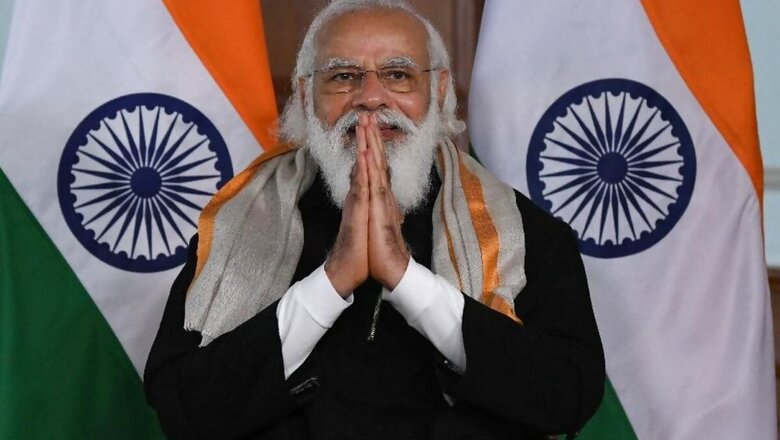
views
Temple visits, including in Bangladesh, are not new to India’s Prime Minister Narendra Modi. But the inclusion of two temples—particularly, one that belongs to a scheduled caste sect—in his itinerary, during his visit to Dhaka, has evoked great interest in India.
Modi’s critics feel this would help him consolidate the Hindu votes in West Bengal during the ongoing election season. While the validity of the apprehension is debatable, the controversy has helped the Prime Minister attract the spotlight. And, that’s probably the biggest gain for the BJP, which had to spare its star campaigner for two days during a busy election season.
To start with, Modi had little to do with either the timing of the visit or the election. Bangladesh is commemorating 50 year of its independence and the birth centenary of its founding father ‘Bangabandhu’ Sheikh Mujibur Rahman. The present Prime Minister of Bangladesh, Sheikh Hasina, is the daughter of ‘Bangabandhu’.
Bangladesh: An important partner
The Indian Prime Minister will be attending the valedictory session of a 10-day programme. It is not an occasion to do business, and Modi and Hasina are unlikely to enter into any major bilateral agreements. However, they will surely discuss issues of shared interests. Bangladesh is likely to push for sharing of common resources, particularly the Teesta water-sharing agreement, which is pending for a long time due to the objections raised by West Bengal Chief Minister Mamata Banerjee.
For India, Bangladesh is an important partner not only in terms of burgeoning trade or broad-spectrum economic cooperation initiatives but to also ensure regional as well as internal security. If Assam became peaceful over the last decade, Hasina contributed to it significantly.
ALSO READ| Bengal is Learning a New Language—That of Hindutva-led Caste Identity Politics
Having said that India has some concerns pertaining to Islamist activities and the status of minorities in Bangladesh, which has cross-border implications. It is true that Bangladesh has been the safest during the Hasina rule. However, it is also true that the Islamists are not leaving any opportunity to challenge the status-quo. The recent atrocities on Hindus in Sunamganj and violent protests against Modi’s visits are reminders to that.
On that count, the selection of Jeshoreshwari Kali Temple, one of the 51 Shakti-Peethas in Hindu mythology, for Prime Minister’s visit is interesting. The temple is located in Ishwaripur village in Satkhira district of Bangladesh. Satkhira shares border with North 24 Parganas district of West Bengal and is referred to as one of the two major hubs of radical activities in Bangladesh.
Temple visit: Impact unclear
The Jeshoreshwari temple is significant in another way. This nondescript village was the seat of power of Maharaja Pratapaditya (1561-1611), who attained iconic status for declaring independence from the Mughals. Most prominent among the confederacies of soldier-landowners, who were known as the ‘Baro-Bhuyan’, in Assam and undivided Bengal, Pratapaditya ruled over large parts of South Bengal, including parts of Kolkata.
However, this piece of history is barely remembered in today’s Bengal and has zero relevance in election. The Prime Minister’s visit will, at best, improve the local sentiments and may pave the way for converting the temple into a tourist attraction in the longer run.
On the opposite spectrum is the Matua shrine at Orakandi in Gopalganj district of Bangladesh. Known as the ancestral home of ‘Bangabandhu’, the district has one of the largest concentrations of Hindu villages on either side of the border. To put it in perspective, if Hindus are any less secure in Satkhira, they are most secure in Gopalganj.
Some 100 kms from the Petrapole border in West Bengal, Orakandi is the birthplace of Harichand Thakur, who founded the Matua sect, sometime around 1860, as part of social reform of a section of lower caste Hindus. Matuas, most of whom have shifted to India, constitute a significant portion of the 23 per cent scheduled caste population in West Bengal, who are the BJP’s biggest bet to neutralize the impact of Muslim votes.
CAA is more important
For many years after Partition, Matuas used to travel to Orakandi during the annual festival of “Baruni Snan Utsav”, in the month of ‘Falgun’ (February-March). However, the flow of pilgrims reduced with time. This is partly due to lack of institutional support from either India or Bangladesh and the rise of an alternate centre at Thakurnagar in Bangaon, right across the border, in West Bengal.
ALSO READ| In TMC vs BJP Bengal Fight Over Matuas, the Rise of a Community and Its Caste Assertion
The Prime Minister’s visit and some possible announcement to pave way for pilgrimage from India to Orakandi may strike a chord with the Matuas. However, it is questionable if it would make any major impact in the poll results. Majority of the Matuas have already shifted allegiance to BJP as was evident in the party winning from Bongaon Lok Sabha constituency in 2019. The support has gained momentum after the enactment of the Citizenship (Amendment) Act in December 2019.
Like majority of the refugee population in West Bengal, Matuas are now eagerly awaiting the implementation of CAA, as it would help clear the legal mess over their citizenship status. The prevailing rules do not differentiate between Hindus who migrated to India due to religious persecution and Muslims entering the country for economic opportunity. A status-quo will help Mamata protect her Muslim constituencies.
To sum up, the temple visits may help Narendra Modi maintain the tempo of the BJP campaign in West Bengal, but it may not have much impact, directly, on the ballot box.
Read all the Latest News, Breaking News and Coronavirus News here



















Comments
0 comment